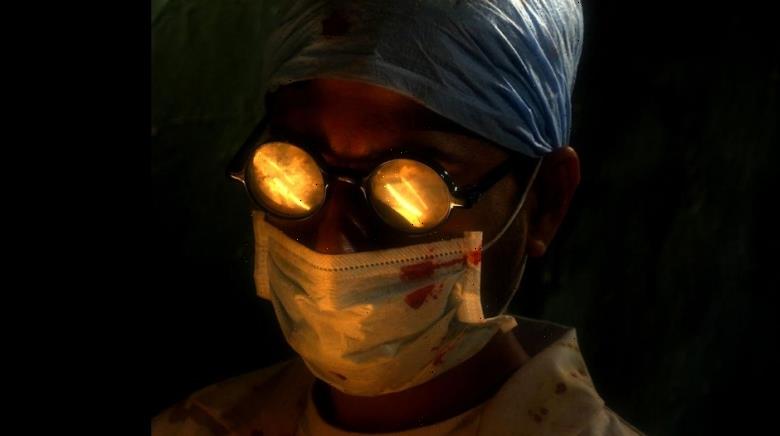Despite stop-motion animation mostly focusing on children’s movies nowadays, with LAIKA and Aardman leading the charge for the medium’s cinematic output, the animation technique has always lent itself toward horror. As films like “Coraline” prove, no matter how cute the puppets work their mere movements already make them creepier than hand-drawn animation ever could. Oscar-winner VFX artist Phil Tippett recognizes this, so his feature directorial debut “Mad God” quickly turns into an ugly, gruesome Dantean trip through hell.
Even if you don’t know the name Phil Tippett, you definitely know his work. The legendary VFX artist has revolutionized creature design, stop-motion, and CG-character animation, having worked in everything from “Star Wars,” and “RoboCop,” to “Piranha” and “Jurassic Park.” His passion project, “Mad God,” is 30 years in the making, with Tippett shooting early footage during the making of “RoboCop 2” before shelving the project until the ’00s, when he started slowly adding to the epic production. The result is a film that takes decades worth of Tippett’s work within the Hollywood blockbuster system, throws all that into the fiery pits of hell, adds some theology, William Blake, Hieronymus Bosch, and silent cartoons, and regurgitates a Miltonesque world of savagery, horror, and plenty of bodily fluids.
The film follows a figure clad in a steampunk-like outfit — complete with a gas mask and trench coat — as he descends in a modified diving bell from the heavens down a pit, past the skulls of titans and into a dystopian nightmare world. Without ever specifying what the masked figure’s objective is, Tippett introduces a cruel, hellish existence full of monsters and cruelty.
The workers that support this world are killed in all sorts of gruesome ways that would make the Cenobites in Clive Barker’s “Hellraiser” explode with joy. They are squashed by road rollers, eaten by giant monsters, fried in electric chairs, or gored by a minotaur they were jerking off. Adding to the sense of surrealist nightmare are the purposely unsetting and ugly creature designs, mixing meat, rusted metal and various fluids to create the dark counterpart of discarded “Star Wars” creatures.
“Mad God” follows a non-verbal narrative structure that doesn’t really pursue a story. Instead, it traces a series of vignettes that paint a picture of a macabre world. As the silent figure carrying a suitcase full of dynamite keeps walking to his unspecified goal, stunning landscapes of nuclear destruction give way to intricate mazes of metal and bones. The film clearly pulls from a wide variety of influences, with the set and production designs looking like if Fritz Lang directed a Fleischer cartoon. Despite this being his first feature directorial effort, Tippett does an impressive job framing the action, with Tippett and co-director of photography Chris Morley making the visuals tell the story, with the frenetic camera movements saying more than words ever could. He and Morley pull off some impressive tracking shots through labyrinthine factories full of monsters that rival the biggest blockbuster productions.
The lack of dialogue and a straightforward plot is reminiscent of another recent animated epic made by an auteur free of norms and conventions: Genndy Tartakovsky’s “Primal.” Like “Primal,” Tippett’s “Mad God” is a cacophony of savagery and cruelty, but where the former uses that to tell an emotional tale of a caveman and a T-Rex connecting through grief, “Mad God” offers no hope, no respite from the awe-inspiring terror. The film opens with a passage from Leviticus, which encapsulates the film’s apocalyptic tone: “Your land shall become a desolation and your cities a ruin.”
Not even limited to stop-motion, Tippett also employs live-action filmmaking at several points in the film, featuring actual actors in costume — including “Repo Man” director Alex Cox as a curly fingernailed mad scientist. Though the designs and costumes fit the hellish world of the film, these segments are far removed from the rest of the film to the point where they feel like a distraction from what little actual plot the movie has — even if we do get some of the best elements of body horror during these scenes.
“Mad God” may not tell a conventional story, and it doesn’t include a single piece of dialogue, yet it threatens to overwhelm with the amount of information that is dropped on the audience visually. Each scene, each new circle of hell is filled to the brim with new details that hint at an unseen history with its own conflicts and horrors. Theological and even cosmic themes and horrors are introduced and then quickly set aside for the next thing, which may be a bit too disjointed for some audience members, while just enticing enough to others.
After four decades of crafting creatures for iconic films, Phil Tippett has finally unleashed his magnum opus, and it is worth the wait. “Mad God” exudes devotion, with every frame carrying decades worth of ideas and craft, resulting in a film that is just as hard to describe as it is hard to forget.
Score: B
“Mad God” screened at Fantasia Fest 2021. It is currently seeking U.S. distribution.
Source: Read Full Article
